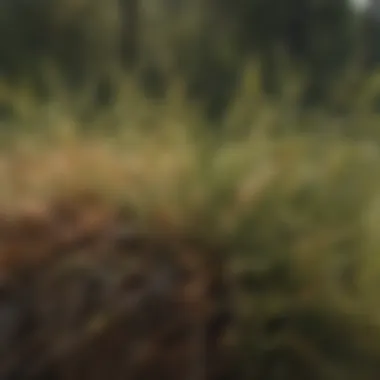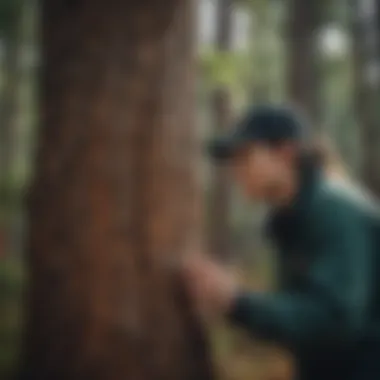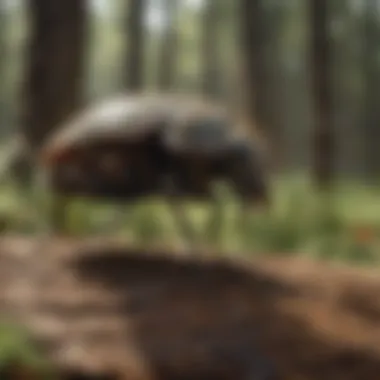Pine Forest Pest Control: Strategies and Insights


Intro
Pine forests are vital ecosystems that provide habitat for various species and contribute significantly to our environment. Unfortunately, these forests are susceptible to numerous pests, which can disrupt their health and productivity. Understanding how to manage these pests is essential for maintaining a balanced ecosystem.
In this article, we will explore tactics and insights necessary for effective pest control in pine forests. We will identify common pests and their telltale signs, discuss prevention methods, and offer practical DIY solutions. By emphasizing sustainable practices, we aim to empower homeowners and forest land managers in safeguarding their pines against unwanted invaders.
Pest Identification
Identifying pests in pine forests is crucial, as early detection can significantly reduce the impact of infestations. Various insects, fungi, and diseases threaten the well-being of these trees.
Common Pests
Among the significant pests affecting pine forests, the following stand out:
- Bark Beetles: These small insects bore into the bark, causing damage that can lead to tree mortality. Species like the mountain pine beetle are particularly notorious.
- Pine Weevils: Known to damage the young shoots, they can weaken seedlings and ultimately reduce growth rates.
- Gypsy Moths: These caterpillars can defoliate pines, leading to stress and increased susceptibility to diseases.
Signs of Infestation
Recognizing the signs of pest infestations is critical. Homeowners should look for:
- Discoloration of Needles: Yellowing or browning needles can indicate stress from pests.
- Exit Holes: Small holes in the bark can signal beetle activity.
- Visible Larvae or Caterpillars: Finding these on or around trees is a clear indicator of a pest problem.
Prevention Methods
Preventing pest infestations is more effective than treating them after they occur.
Environmental Modifications
Creating an environment less conducive to pests can help. Consider:
- Maintaining Tree Health: Regularly watering and fertilizing pines can help them withstand pest pressure.
- Promoting Biodiversity: Encouraging a mix of tree species can make forests less attractive to specific pest species.
Home Maintenance Tips
For homeowners living near pine forests:
- Clear Debris: Removing fallen needles and branches can reduce pest habitats.
- Inspect Trees Regularly: Frequent checks can help catch potential problems early.
DIY Pest Control Solutions
If an infestation is suspected, there are natural and effective solutions available.
Natural Remedies
Several home remedies can deter pests:
- Neem Oil: This natural pesticide can be effective against various insect pests without harming beneficial species.
- Soap Sprays: A simple mixture of water and liquid soap can help suffocate soft-bodied insects.
DIY Traps and Barriers
Building traps or barriers can provide physical means of pest control:
- Sticky Traps: Placing these traps around tree bases can catch insects before they reach the trunk.
- Barriers of Diatomaceous Earth: This powder can protect seedlings by creating a barrier that pests cannot cross.
Implementing these strategies can significantly reduce pest pressures in pine forests, promoting healthier trees over the long term.
Closure
Pine forest pest control requires a multifaceted approach that involves identification, prevention, and natural control methods. By being aware of the pests that threaten pines and taking proactive steps, homeowners can play a vital role in maintaining the health of these essential ecosystems. Understanding these techniques is key to fostering sustainable forest management.
Understanding Pest Infestations in Pine Forests
Pest infestations in pine forests significantly affects the health and sustainability of these ecosystems. Understanding these infestations is crucial for forest management, conservation efforts, and ensuring that the economy dependent on these resources remains stable. Proper knowledge about pest dynamics allows for the development of effective pest control strategies that are both chemical and non-chemical. This knowledge helps in reducing the impact of pests on tree health.
The Role of Pests in Forest Ecosystems
Pests can often be perceived as detrimental to forest ecosystems; however, it is important to recognize their role in the natural order. They can contribute to the cycling of nutrients, promote biodiversity, and assist in maintaining ecosystem balance.
In some cases, certain pests create space for new growth by damaging older trees, allowing younger ones to thrive. Recognizing this duality is essential for effective pest control measures.


Identifying Common Pine Pests
Several pest species are commonly found in pine forests, and effective pest management requires accurate identification. These pests include bark beetles, ips beetles, white pine weevil, and pine sawflies. Each has distinct characteristics and ways of impacting tree health.
Bark Beetles
Bark beetles are notorious for infesting pine trees. They tunnel beneath the bark, disrupting the transport of nutrients and water. Their key characteristic is their ability to reproduce quickly, leading to widespread damage in a short period. Bark beetles are essential to mention because they can trigger large-scale tree mortality. The unique feature of bark beetles is their connection with fungi, aiding in tree decay, which can be an advantage in the ecosystem but poses a major threat to forest health.
Ips Beetles
Ips beetles are another crucial pest affecting pine trees. These beetles typically bore into the wood and can cause significant damage similar to bark beetles. Their main characteristic is that they can attack stressed or weakened trees, making tree health an important consideration. They are known to reproduce in high numbers, increasing the potential for infestations. The unique feature of ips beetles is their ability to develop new areas of infestation effectively, which heightens their risk for causing widespread damage.
White Pine Weevil
White pine weevil primarily targets the leader shoots of young pines, resulting in deformities in growth. This insect affects the shape of the tree, which can lower its value and growth potential. The key aspect of white pine weevil is its concentrated feeding behavior during the larval stage. Its unique feature includes creating a distinctive shepherd's crook shape in the shoot. This can disadvantage the tree by affecting its overall structure and potential for timber production.
Pine Sawflies
Pine sawflies are recognized for their leaf-chewing habits, targeting the needles of pine trees. Their key characteristic is their social behavior, where they often feed in groups. Pine sawflies can severely weaken trees, especially during high population outbreaks, leading to significant complications for tree health. A unique feature of pine sawflies is their life cycle, which can lead to rapid population spikes in favorable conditions. Understanding their impacts can assist in better forest management practices.
Life Cycle and Behavior of Pine Pests
Pine pests exhibit diverse life cycles that adjust according to environmental conditions. Understanding these patterns is important for timing control measures effectively. Each pest develops in phases, involving eggs, larvae or nymphs, and adults. The growth rates and survival of these pests can vary greatly, often influenced by factors such as temperature and moisture. Knowing when and where these pests develop can help in managing populations before they inflict significant damage.
Symptoms and Signs of Infestation
Recognizing the symptoms and signs of pest infestations in pine forests is critical for effective management and preservation of these ecosystems. Timely identification can make a significant difference in mitigating the impact of pests before they cause extensive damage. Common symptoms include physical damage to the tree, changes in foliage, and more subtle signs of stress that can indicate underlying issues.
Properly understanding what to look for not only aids in pest identification but can also inform appropriate management strategies. Homeowners and land managers must be keen observers of their pine trees, as ignoring early symptoms can lead to extensive infestations that are harder to treat and often require more drastic measures.
Visual Indicators of Damages
Visual indicators serve as the most immediate and obvious signs of pest problems in pine forests. Damage can manifest in several ways:
- Bark Holes: Small holes in the bark can indicate activity from species such as bark beetles. These holes are often surrounded by frass, which is a sign of pest feeding.
- Discoloration of Needles: Yellowing or browning of needle foliage can be a symptom of stress, often caused by pests. In some instances, needles may drop prematurely.
- Branch Dieback: If limbs are dying from the tips inward, this may indicate that pests are targeting specific areas of the tree. Noticing this early can help halt further decline.
- Galleries and Tunnels: Some pests create visible galleries or tunnels under the bark. This type of damage affects the tree's ability to transport nutrients and can eventually lead to its death.
Identifying these visual indicators requires careful inspection. Engaging in regular checks of pine trees for these visible signs can help in catching infestations early.
Understanding Tree Health Decline
Tree health decline is often a gradual process that can be caused by various factors, including pest infestations. Pests can weaken trees, making them more susceptible to diseases and other environmental stressors. Understanding how these pests affect tree health is vital for sustainable management.
Factors to consider include:
- Changes in Growth Rate: A noticeable reduction in growth can signal stress. Pests disrupt the tree's normal physiological processes, leading to stunted growth.
- Overall Health: Trees that are infested often display overall poor health, such as wilting leaves and lackluster bark. The general vigor of a tree is a tell-tale sign of its vulnerability.
- Increased Susceptibility to Disease: Infested trees are more prone to infections. Bacteria and fungi exploit the weakened condition caused by pests, further exacerbating health decline.
By observing these signs and maintaining awareness of tree health, effective measures can be developed to address any infestations and promote recovery.
Identifying symptoms of infestation not only prevents significant ecological damage but also helps maintain healthier, more resilient pine forests.
Assessing the Impact of Pests on Pine Forests
Evaluating the effects of pests on pine forests is essential for several reasons. Understanding how these pests influence forest dynamics can lead to better management practices, enhance ecosystem health, and ensure economic stability.
Pine forests provide numerous ecological benefits, serving as habitats for diverse species, carbon sinks, and sources of timber and non-timber products. Infestations can disrupt these benefits, leading to long-term consequences for both the environment and human interests. Recognizing the impact of pests allows for timely interventions and improved strategies for maintaining forest integrity.
Economic Consequences
The economic ramifications of pest infestations in pine forests can be significant. Timber production is a major industry, particularly in regions heavily reliant on coniferous trees. When pests damage or kill trees, it can lead to reduced yields and lower quality timber. This decline directly affects forestry companies and the economy, as products derived from these resources become scarce and expensive.
Additionally, the costs associated with pest management can strain budgets. Landowners may need to invest in control measures such as fumigations or chemical sprays, which can be costly and labor-intensive. Failure to address pest issues promptly can result in even larger financial losses down the line, making it imperative for stakeholders to implement effective monitoring and management practices to mitigate these risks.
For example:
- Loss of timber: Declining tree health reduces the quantity and quality of timber available for harvest.
- Increased management costs: Hiring pest control professionals or purchasing insecticides adds financial burden.
- Market impact: Sustained damage can lead to market fluctuations, affecting prices and availability of timber-based products.
Ecological Implications


The ecological implications of pest infestations extend beyond immediate economic effects. Pests can alter the composition and structure of pine ecosystems. For instance, when certain pests dominate a habitat, they can outcompete native species and disrupt food webs. This imbalance can reduce biodiversity and affect the resilience of the forest to other environmental stresses, like climate change.
Moreover, the decline of healthy pine forests due to pests can impact soil health and water retention. Fewer trees can lead to increased erosion and decreased quality of water supply for surrounding areas. Pests may also increase vulnerability of forests to diseases, resulting in cascading effects that threaten entire ecosystems.
"A healthy forest is vital, not just for the trees, but for the entire ecological community that depends on them."
Recognizing these ecological consequences is crucial in fostering a comprehensive strategy for pest management. Sustainable practices that consider the interconnections within ecosystems can lead to healthier forests, benefiting both the environment and the economy.
Pest Control Strategies
Pest control strategies are essential for maintaining the health of pine forests. These strategies encompass a range of methods designed to reduce pest populations and minimize their impact on the ecosystem. Understanding various strategies allows landowners and managers to implement effective measures tailored to specific infestation scenarios. It also plays a crucial role in ensuring the sustainability and resilience of these forests against recurring pest threats.
Cultural Control Methods
Cultural control methods involve practices that enhance tree health and reduce the likelihood of pest infestations. This includes selecting pest-resistant tree species and practices such as proper tree spacing, which can improve air circulation and reduce humidity levels, making an unsuitable environment for many pests. Other methods include maintaining soil health with organic matter and practicing regular monitoring for early signs of pest presence. These preventative measures are usually more sustainable as they work in harmony with the forest ecosystem rather than against it.
Biological Control Options
Biological control options utilize natural predators or parasites to keep pest populations in check. This approach relies on the introduction of beneficial organisms such as lady beetles or parasitic wasps that target specific pests affecting pine trees. Utilizing these natural enemies can minimize chemical intervention and foster a balanced ecosystem. It also helps in enhancing biodiversity in the forest, promoting resilience against future infestations. However, awareness of the ecological impact is crucial when introducing new species into the environment.
Chemical Control Measures
Chemical control measures involve the use of insecticides to manage pest populations effectively. Insecticides can quickly reduce pest numbers and are often necessary in severe infestations. However, they must be used judiciously to avoid potential negative effects on non-target species and the environment.
Insecticides
Insecticides play a key role in pest control within pine forests. They are specifically formulated to target a range of pest species and can be an effective solution when infestations become overwhelming. An important characteristic of insecticides is their effectiveness; they can rapidly reduce pest populations, giving trees time to recover. However, they may also harm beneficial insects and disrupt the natural ecological balance when not applied carefully. Their effectiveness largely depends on timing, application method, and the specific pest being targeted.
Targeted Application Methods
Targeted application methods refer to precise techniques for administering insecticides only to affected areas, minimizing contact with beneficial species. This approach is advantageous because it reduces the environmental impact often associated with broad-spectrum spraying. Techniques such as spot treatments or localized injections allow for a targeted response to infestations. The unique feature of these methods is their ability to deliver treatments where needed most without excessive chemical use. However, careful monitoring is required to ensure effective results and avoid under-treatment or over-reliance on chemicals.
The integration of various pest control strategies can create a comprehensive approach to managing pest infestations in pine forests. The balance between cultural, biological, and chemical methods is vital for long-term sustainability.
Integrated Pest Management (IPM)
Integrated Pest Management (IPM) plays a vital role in the effective control of pests in pine forests. It is an approach that combines multiple tactics to manage pest populations while minimizing the impact on the environment, human health, and non-target organisms. IPM is not just about the immediate elimination of pests; rather, it focuses on long-term prevention and the sustainable management of ecosystems. This comprehensive strategy recognizes the complex interrelations between pests, plants, and their habitats, allowing for more informed decision-making.
Utilizing IPM can lead to several benefits. First, it integrates different strategies such as biological, cultural, and chemical controls. This diverse toolbox ensures that forest managers can adapt to evolving pest challenges. Second, IPM promotes the natural enemies of pests, allowing ecological balance. It encourages practices that maintain habitat suitability for these beneficial organisms. Lastly, this method reduces over-reliance on chemical pesticides, thereby protecting forest ecology and enhancing public acceptance of pest management initiatives.
However, implementing IPM does have considerations. Each forest is unique, meaning that strategies must be customized based on specific pest species, environmental conditions, and land use methods. Moreover, ongoing education and training for forest managers and homeowners are crucial to ensure that IPM practices are effective and up-to-date.
Principles of IPM in Pine Forests
The principles of IPM in pine forests emphasize several key components. The first principle involves understanding the pest life cycle and its ecological interactions. This knowledge aids in identifying critical points for intervention. Integrated monitoring practices can help prevent pests from reaching damaging population levels.
Another guiding principle is promoting optimal tree health. Healthy trees are less susceptible to infestations. Measures such as selecting resistant varieties and maintaining soil quality are important. Regular tree assessments also play a crucial role.
Lastly, IPM principles prioritize the use of control measures that are least harmful. This involves employing non-chemical methods first, like cultural practices that might alter pest habitats, before considering chemical treatments only when necessary.
Monitoring and Evaluation Techniques
Monitoring and evaluation are critical components in the IPM framework. These techniques help ensure that pest management strategies are effective over time. Regularly checking pest populations and tree health allows a proactive approach rather than a reactive one.
Some effective monitoring techniques include:
- Visual inspections: Regularly checking the forest for visible signs of pest damage.
- Pheromone traps: Using traps baited with chemical signals to attract pests can provide data on pest populations.
- Remote sensing: Technology such as drones and satellite images can help track tree health and pest spread across larger areas.
Evaluation techniques are equally necessary. After implementing a pest control strategy, assessing its impact is essential. Forest managers must collect data on pest population changes, tree health, and the effectiveness of control measures used. This information can guide future pest management tactics and improve overall strategies.
Monitoring and evaluation not only improves pest control measures but also contributes to a better understanding of pest dynamics in pine forest ecosystems.
Innovative Approaches to Pest Management
In the field of pest control, innovative approaches are essential for effective management of pine forests. As pest populations evolve, traditional methods may not always suffice. Embracing new ideas can lead to improved outcomes in controlling pests while minimizing ecological impact. By integrating technology and research, we can enhance our understanding of pest behavior and develop more efficient control tactics that also prioritize sustainability. These methods are instrumental not only in managing current infestations but also in anticipating future outbreaks.
Use of Technology in Pest Control


Drones
Drones represent a groundbreaking technological advancement in pest management. Their ability to cover large areas quickly makes them a valuable tool for monitoring pine forests. Drones equipped with cameras can assess forest health, identify infested trees, and gather vital data on pest populations. The key characteristic of drones is their aerial perspective, which allows for real-time surveillance that would be time-consuming and labor-intensive if done by foot.
One beneficial aspect of drones is their ability to conduct high-resolution imaging. This helps in pinpointing problem areas and focusing control measures accordingly. However, one disadvantage is the initial investment cost and the need for trained personnel to operate them effectively.
Remote Sensing
Remote sensing technology offers another layer of insight into pest management. This involves gathering data from a distance, often using satellite imagery or specialized sensors that detect changes in forest health. Remote sensing provides a broad overview of ecosystem conditions, enabling managers to spot stress indicators in pine trees that may be linked to pest activity.
The key characteristic of remote sensing is its capacity for comprehensive data collection over extensive landscapes. This is beneficial for understanding trends over time, as it allows for the analysis of large-scale ecological changes. Unique features include the ability to detect subtle changes in plant health before visible signs of infestation appear. However, reliance on technology can sometimes limit the immediacy in addressing pest issues since data interpretation and response may not be instantaneous.
Research and Development in Pest Control
Continuous research and development are critical for staying ahead of pest challenges. Innovations in pest control stem from studying pest biology, behavior, and interactions within their environment. New insecticides, biological control agents, and sustainable practices are always being explored to enhance existing pest management protocols.
Furthermore, this research encompasses evaluations of the efficacy and safety of new methodologies. A focus on integrated pest management systems is central, ensuring that diverse strategies work cohesively. These developments not only improve pest control outcomes but also contribute to preserving the health of pine forests and the overall ecosystem health.
Sustainable Practices in Pine Forest Management
Sustainable practices in pine forest management are crucial for maintaining ecosystem health and ensuring the longevity of forest resources. These methods recognize the interconnectedness of forest ecosystems and promote a balanced approach to conservation and resource use. Within this framework, sustainable management seeks to minimize environmental impact while enhancing the resilience of pine forests to pests and diseases.
One significant advantage of sustainable practices is the enhancement of soil health. Healthy soil supports better tree growth and reduces susceptibility to pest infestations. Using organic amendments, such as compost or mulch, can naturally improve soil structure and fertility, leading to stronger pine trees. This, in turn, lowers the need for chemical fertilizers that could harm the environment.
Another essential consideration is the regulation of timber harvest. Sustainable forestry practices advocate for selective logging rather than clear-cutting. This method helps preserve the ecosystem's balance and mitigates habitat destruction. By maintaining some of the forest's structure, there are more resources and habitats for beneficial insects, birds, and other wildlife that can contribute to pest control.
Education and awareness for homeowners and land managers are vital components of sustainable management. Understanding the local ecosystem dynamics can encourage practices tailored to specific challenges faced by pine forests. Homeowners should be informed about native species that can coexist with more commercially viable pine trees. This knowledge helps sustain biodiversity, providing a natural buffer against invasive pest species.
"Sustainable forestry recognizes the need to balance human demands with the preservation of forest ecosystems."
Ecological Forestry Practices
Ecological forestry practices focus on using natural processes to manage pine forests sustainably. These methods prioritize the inherent strengths of ecosystems and promote biodiversity as a way to combat pest populations. For instance, planting a variety of tree species alongside pines can create a more resilient environment. Research shows that diverse forests are less prone to widespread pest outbreaks.
Control methods in ecological forestry include using natural predators to manage pest species. For example, introducing ladybugs can reduce aphid populations without chemicals. These practices align well with the principles of integrated pest management, enhancing the overall health of pine forests without harming non-target organisms.
Promoting Biodiversity
Promoting biodiversity is essential for sustainable pine forest management. Biodiverse ecosystems are typically healthier because they contain a variety of species that can fulfill different roles within the environment. For instance, certain plants can attract pollinators, while others may deter pests, reducing reliance on chemical pesticides.
Homeowners can take small steps to promote biodiversity in their pine forests. Planting native shrubs and flowers not only adds to the beauty of the area but also supports local wildlife. A diverse range of plant species provides food and habitat for various creatures, creating a more balanced ecosystem.
Further, maintaining deadwood and fallen logs in the forest provides habitat for insects and microorganisms that contribute to decomposition. This natural process enriches the soil and supports healthy plant growth. In the long term, fostering biodiversity will likely lead to a decrease in pest outbreaks and disease spread, creating a more sustainable pine forest.
Epilogue
The conclusion of this article emphasizes the vital importance of effective pest control strategies in pine forests. Acknowledging the complex interplay between pest species and forest health is essential. Each pest species, from bark beetles to pine sawflies, contributes to the ecosystem in unique ways. Understanding these roles allows for more informed decisions regarding management strategies.
Pest control not only ensures the health and viability of pine trees but also preserves ecosystem services that these forests provide. Healthy pine forests offer benefits such as carbon storage, water filtration, and habitat for diverse wildlife. Therefore, maintaining the balance between pest species and tree health is crucial.
In addition, the discussion on integrated pest management (IPM) illuminates the multifaceted approaches available. These strategies include cultural, biological, and chemical methods, all aimed at minimizing environmental impacts while maintaining pest populations at acceptable levels. This balanced approach can help address the increasing concern over ecological sustainability.
Finally, the consideration of innovative technologies highlights the evolution of pest management. By utilizing tools such as drones and remote sensing, modern forest management practices can improve monitoring and response times to pest outbreaks.
The future of pine forest management hinges on a combined understanding of pest dynamics and sustainable practices for long-term health and balance.
Through careful management and research-driven strategies, homeowners and pest control professionals can effectively contribute to the preservation of pine forests.
Summary of Key Findings
This article shed light on several critical points regarding pest control in pine forests:
- Identifying pests is the first step to effective management.
- Integrated Pest Management (IPM) is key, balancing various strategies for sustainable outcomes.
- Innovative technologies are transforming pest monitoring and control, allowing for timely responses.
- Sustainable practices contribute to healthier ecosystems, enhancing overall forest resilience.
Understanding these concepts is essential for homeowners and forest managers in making informed decisions that promote healthy pine forests and mitigate pest impacts.
Future Directions for Research
Looking ahead, research in the field of pest management for pine forests can take several paths:
- Continued exploration of ecological interactions among pest species and their hosts, leading to better management practices.
- Innovative technology development for pest monitoring and control, which could further enhance response efforts.
- Evaluating long-term impacts of various pest control measures on biodiversity and ecosystem health to identify best practices.
- Investigation into the effects of climate change on pest dynamics and pine tree resilience.
By pursuing these areas of research, the field can evolve, enabling homeowners and professionals to better address the ongoing challenges of pest management in pine forests.















